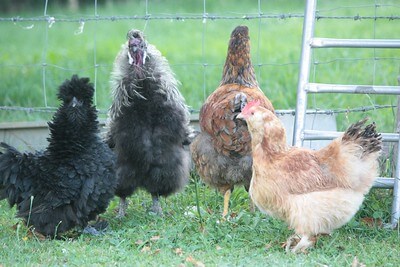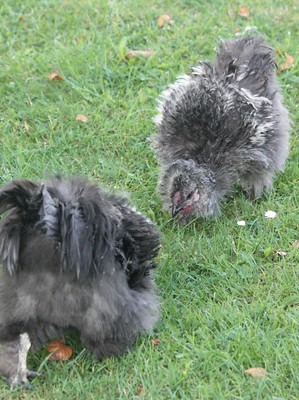Do you love chickens? Do you like Polish food? We have the chicken for you- introducing the polish frizzle chicken- one of the friendliest and most unique chicken breeds.
Keep reading to learn everything you need to know about this chicken breed!
Frizzle Breed Profile
What is a frizzle chicken?
The word “frizzle” refers to this breed of chicken’s curled, kinky feathers. Frizzling is a genetic mutation that causes the feathers to grow this way.
In the poultry industry, frizzle chickens are sometimes referred to as exhibition breeds or show chickens. In other words, they look interesting and do well in shows because they have a unique appearance. This breed comes in both Standard and Bantam sizes.
To tell if a chick is a polish frizzle, look at the feathers around its neck. If they stand up and point backward, it’s likely a polish frizzle.

What Is the Difference Between a Polish Frizzle Chicken and A Polish Chicken?
While both polish frizzle and polish chickens have feathers that stand up and point backward, polish chickens do not have the same curled, kinky feathers. The feathers of polish chickens are more smooth and lay down flat. Their eggs are white, rarely go broody, and are not necessarily frizzles. Some varieties are bearded and non-bearded, too.
Additionally, polish frizzle chickens tend to be smaller than polish chickens.
History of Polish Chickens and Frizzles
Little is known about the history of polish frizzles, but they were likely bred from polish chickens at some point. Aside from polish breeds, frizzle chickens can also be found in many other breeds, such as Cochin, Pekin, Plymouth Rock, and Silkies.
Background of Frizzle Chicken
The origin of the Frizzle is unknown. It is thought that the frizzle gene originated in Asia, especially in China or India, in the 1600s. Charles Darwin had a theory that there were many of them in India, which he based on his observations. Then, he called frizzle chickens Caffie Fowl in 1800. There is no indication, though, that he ever traveled to India himself, it is not known how he obtained this information.
Eventually, more and more of them were brought to western countries as breeding stock. Today, it is recognized in many European countries, including France, Germany, Italy, Poland, and the United Kingdom.
History of Polish Chickens
Polish chickens have an obscure history, and most experts don’t believe they came from Poland, so there are few consensuses. Most people think their name came from their appearance. They look like feathered caps worn by Polish soldiers.
They also say the word ‘Pol’ means large-headed, so they got their name ‘Polish’.
There are already paintings depicting the Polish chicken dating back to the 15th century. It wasn’t until the 1700s that Polish chickens were found in England.

Frizzle Breed Standards
The American Poultry Association and the British Poultry Standard recognize the frizzle chicken. In America, polish frizzles come in both Standard and Bantam sizes.
Additionally, polish frizzles can come in various colors: white, black, blue, buff, partridge, and silver. While polish frizzles are the most popular frizzled breed, they’re not the only ones! There are many other breeds of frizzled chickens, including Cochins, polish apples, sultan chickens, and Japanese bantams.
Polish frizzled chickens are a great place to start if you’re interested in frizzled chickens!
Now that you know a little about the history of polish frizzles let’s look at some of their key characteristics.

Behavior and Temperament of Polish Frizzle Chickens
Polish and Frizzles are generally sweet, friendly, and gentle. They are lovely and quiet chickens. You can also tell the character of a frizzle by what breed it was bred to. Often, a polish frizzle can be relatively low on the pecking order due to its mild temperament
Their docile temperament can make them vulnerable to harassment from more aggressive breeds. They may do better in a smaller flock or with less assertive breeds of chickens. As they are shy birds, they are likely to be bullied by assertive breeds.
There is also a tendency for the Polish chicken bird to become flighty and nervous due to the hair over its eyes. So, you’ve got to be careful when mixing them with other breeds – more aggressive breeds won’t resist pulling out their feathers. With their size, they may do better in a smaller flock or with less aggressive breeds of chickens.
Polish frizzle is a beautiful and unique breed with intense grooming and hygiene needs. Whether in cold or hot conditions, the Frizzle requires special attention in severe weather conditions.
Polish chickens make great county fair birds because they are so docile. Their uniqueness will make them stand out.

Typical Appearance
Polish frizzle chickens have curled or kinked feathers. Depending on the breed, they appear neatly rolled or untamed like a feather duster. These feathers can be either straight or wavy.
The feathers on its breast and abdomen will stand up and point backward, giving the bird a “puffed up” appearance. Additionally, polish frizzle chickens have small to medium-sized, V-shaped combs and wattles. They also tend to have featherless faces.
The species’ beak is short and strong, yellow or horn in color, and its eyes are lively and red in color. The legs are typically yellow or orange. However, you may also find polish frizzle chickens with greenish-yellow legs.
Most polish frizzle chickens are white and black. However, you may also find polish frizzle chickens that are black, blue, buff, silver, or splash.

Size and Weight
As mentioned before, polish frizzles come in both Standard and Bantam sizes. Standard polish frizzles weigh between 4 and 6 pounds, while frizzle bantams only weigh 2 to 3 pounds.
Life Expectancy
Polish frizzles typically have a lifespan of 5 to 10 years. However, polish frizzles have been known to live for 15 years.
Egg & Meat Production (Egg Color and Size

Polish frizzles are not reliable egg layers. They are poor in this area. Typically, a hen will lay 2 or 4 eggs a week. That means you are getting 150-200 eggs per year.
A Polish frizzle lays white to creamy colored eggs, sometimes tinted. They begin laying around five months earlier than most other breeds. In comparison to other breeds, they lay later in the season. But once they warm up, they’re pretty consistent.
If you decide to raise them, remember that they are intended primarily for show and companionship. If you want to breed it for eggs, provide it with a protein-based diet. It improves egg production and can even stimulate feather growth in Frizzles. Raising them for meat is not recommended due to their small size.
What Is It Like To Own a Frizzle Chicken

Common Health Issues
Frizzle chickens are generally healthy birds. However, like all chicken breeds, polish frizzles are still susceptible to:
– Respiratory problems
– Bacterial infections
– Parasites
– Marek’s disease
– Newcastle disease
– Avian influenza
Special Care to Keep Them Clean and Dry
To keep your polish frizzle chickens healthy, keeping their living quarters clean and dry is important. A dirty and wet environment can lead to respiratory problems and other health issues.
Additionally, polish frizzle chickens have feathers that are close to their skin. This makes them more susceptible to bacteria and parasites. To prevent this, make sure to keep their living area clean and free of any potential hazards.
With their limited vision, they need an easy-to-navigate, clutter-free environment. The safer they feel, the happier they will be. Make sure nothing is within their reach that they can get trapped in.

Nutrition and Feeding
They have the same needs as most other breeds. They need nutritious food and access to fresh water.
However, because they are reliable egg layers, Polish frizzle chickens need a high-quality feed or a diet high in protein. This will help increase their egg production and promotes healthy feathers – grow strong and stay healthy.
Breeding Polish Frizzles
It’s hard to breed polish frizzle chickens because they have such a small gene pool. The genes that cause the frizzled feathers are unstable and may not be passed down to all chicks. As a result, you may have polish chicks that do not have frizzling feathers. So, to increase your chances of getting frizzle chicks, you should breed two polish frizzles together.
The Livestock Conservancy lists polish frizzles as a “threatened” breed of chicken. This means that polish frizzles are in danger of becoming extinct.
Benefits of polish frizzle chicken

Polish frizzles are great foragers but would remain happy even when confined. Though they can roam freely, ensure you provide them with some protection. They are also small chickens, so you don’t need a very large chicken coop for them. Your fences only need to be tall enough to keep predators out.
They are easy to tame and are very calm and easygoing. Considering its unique appearance, one might expect this bird to be attractive. A beautiful creature you get to see every day!
Chickens like these are also good brooders and good mothers. It doesn’t matter how ridiculous their feathering is. You can trust them to take care of their young chicks.
Drawbacks of polish frizzles
Because of the curly, thin feathers of frizzle chickens, they need severe cleaning and maintenance. You may have trouble finding dirt with all the feathers around them.They will need a warm, well-ventilated coop in the winter to prevent chilling.
It is also vital to watch predators such as dogs, cats, foxes, and hawks. Almost all predators are attracted to birds with frizzled feathers due to their dense feathers and small size.
Chickens like Frizzles can’t fly high, so roosting is not easy for them. Especially if you place the roosts too high above the ground, you will have difficulty controlling the birds.
Buying a frizzle chicken
When it comes to buying polish frizzle chickens, you have a few options. You can purchase them from a hatchery or breeder or buy them online.
We recommend visiting the facility if you purchase polish frizzle chickens from a hatchery or breeder. This will allow you to see the chickens in person and ask the staff any questions that you may have.
If you decide to buy polish frizzle chickens online, we recommend purchasing them from a reputable online seller. There are a lot of scams online, so you must do your research before making a purchase.
Common Questions about Frizzle Chickens
Below are some of the most common questions that people ask about frizzle chickens:
1. What do frizzle chickens eat?
Frizzle chickens need a diet that is high in protein. Additionally, they need a diet containing all essential vitamins and minerals. A good way to ensure that your polish frizzles get all of the nutrients they need is to feed them a commercial chicken feed designed specifically for polish frizzles.
2. Does frizzle chicken need a heated chicken coop?
Frizzle chicken does best in warm weather. If you live in an area with cold winters, you’ll need to provide your polish frizzles with a heated chicken coop.
3. What is the difference between a frizzle chicken and a sizzling chicken?
Frizzle chicken has curly feathers. While sizzle chickens have feathers that not only curl outward but also lack barbicels.
Summary
There you have it! That’s everything you need to know about polish frizzle chickens. We hope you now have a better understanding of these beautiful birds. Hope this guide has been helpful, and thank you for reading!

